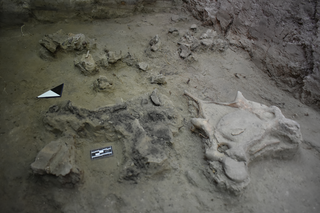We present the results of the excavations and analyses of the diverse and exceptional archaeological assemblage of Taguatagua 3, a new late Pleistocene site located in the ancient Tagua Tagua lake in Central Chile (34°S). The anthropogenic context is constrained in a coherently dated stratigraphic deposit which adds new information about the mobility, subsistence strategies, and settlement of the early hunter-gatherers of southern South America. The age model constructed, as well as radiocarbon dates obtained directly from a combustion structure, indicate that the human occupation occurred over a brief time span around 12,440–12,550 cal yr BP. Considering taphonomic, geoarchaeological, lithic, archaeobotanical, and zooarchaeological evidence, as well as the spatial distribution combined with ethnographic data, we interpret Taguatagua 3 as a logistic and temporary camp associated mainly with gomphothere hunting and butchering. Nevertheless, several other activities were carried out here as well, such as hide and/or bone preparation, small vertebrate and plant processing and consumption, and red ochre grinding. Botanical and eggshell remains suggest that the anthropic occupation occurred during the dry season. Considering the contemporaneous sites recorded in the basin, we conclude that the ancient Tagua Tagua lake was a key location along the region’s early hunter-gatherer mobility circuits. In this context, it acted as a recurrent hunting/scavenging place during the Late Pleistocene due to its abundant, diverse, and predictable resources.

